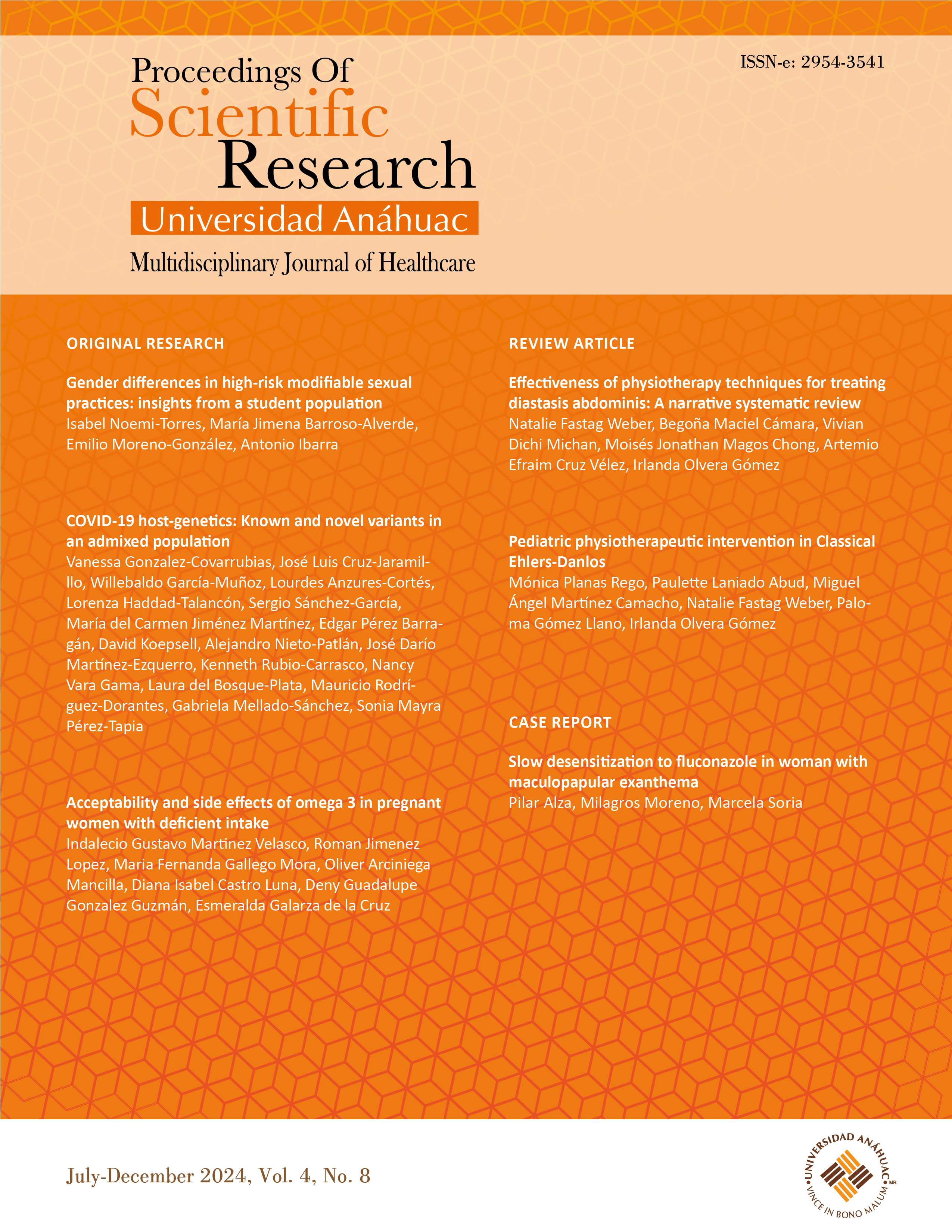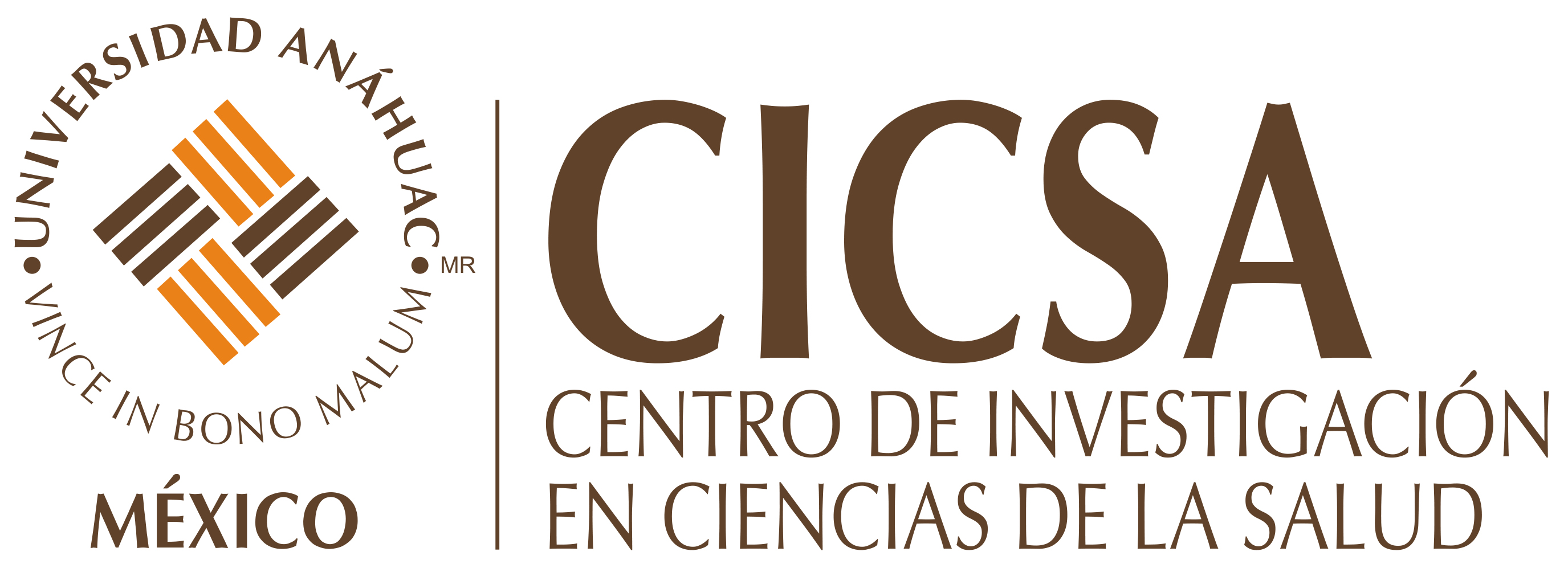Pediatric physiotherapeutic intervention in Classical Ehlers-Danlos
DOI:
https://doi.org/10.36105/psrua.2024v4n8.05Palabras clave:
Síndrome de Ehlers-Danlos (SED), Síndrome de Ehlers Danlos Clásico (cSED), Pediatría, Fisioterapia, Tratamiento, ColágenoResumen
El Síndrome de Ehlers-Danlos (SED) es un grupo de trastornos genéticos del tejido conjuntivo caracterizados por mutaciones en los genes que codifican el colágeno, las enzimas modificadoras de colágeno y otras proteínas de la matriz extracelular. Estas alteraciones generan manifestaciones clínicas como hiperlaxitud articular, fragilidad cutánea y complicaciones musculoesqueléticas, que impactan significativamente en la calidad de vida de los pacientes. Aunque la evidencia científica sobre el manejo fisioterapéutico del SED es limitada, se ha observado que intervenciones especializadas pueden mejorar la estabilidad articular, la fuerza muscular y la funcionalidad, especialmente en pacientes pediátricos. Este artículo tiene como objetivo proporcionar una revisión actualizada sobre el SED en población pediátrica y proponer un abordaje fisioterapéutico integral y multidisciplinario, centrado en la prevención de complicaciones, el manejo de síntomas y la promoción de la participación activa en las actividades de la vida diaria.
Descargas
Referencias
Lozano Sánchez FS, Torres Hernández JA. Epónimos del síndrome Ehlers-Danlos y su variante tipo IV o Sack-Barabas. Angiología. 2017 Nov;69(6):398–400. https://doi.org/10.1016/j.angio.2017.05.001
Abbas AK, Aster JC, Kumar V. Trastornos Genéticos. In: ROBBINS Y COTRAN PATOLOGIA ESTRUCTURAL Y FUNCIONAL. S.l.: ROBBINS Y COTRAN; 2021. p. Capitulo 5.
Malfait F, Francomano C, Byers P, Belmont J, Berglund B, Black J, et al. The 2017 international classification of the Ehlers-Danlos syndromes. Am J Med Genet C Semin Med Genet. 2017 Mar;175(1):8–26. https://doi.org/10.1002/ajmg.c.31552
Basel D. Síndrome de Ehlers Danlos. In: Nelson textbook of pediatrics [Internet]. Edition 21. Phialdelphia, PA: Elsevier; 2020. p. Cap 679 p.3527. Available from: https://www.clinicalkey.es/#!/browse/book/3-s2.0-C20151024243
Mitchell RN, Kumar V, Abbas AK, Aster JC. Trastornos genéticos. In: Pocket companion to Robbins and Cotran pathologic basis of disease. Ninth edition. Philadelphia, PA: Elsevier; 2017. p. 147.
Goldman L, Schafer AI, editors. Goldman-Cecil medicine. 26th edition. Philadelphia, PA: Elsevier; 2020. Cap. 224.
Malfait F, Wenstrup RJ, De Paepe A. Clinical and genetic aspects of Ehlers-Danlos syndrome, classic type. Genet Med. 2010 Oct;12(10):597–605. https://doi.org/10.1097/GIM.0b013e3181f3957f
De Paepe A, Malfait F. The Ehlers–Danlos syndrome, a disorder with many faces. Clin Genet. 2012 Jul;82(1):1–11. https://doi.org/10.1111/j.1399-0004.2012.01858.x
EDS. The Ehlers Danlos Society. 2023 [cited 2023 Nov 19]. Genetics and Inheritance of EDS and HSD. Available from: https://www.ehlers-danlos.com/genetics-and-inheritance/
Bowen JM, Sobey GJ, Burrows NP, Colombi M, Lavallee ME, Malfait F, et al. Ehlers–Danlos syndrome, classical type. Am J Med Genet C Semin Med Genet. 2017 Mar;175(1):27–39. https://doi.org/10.1002/ajmg.c.31554
Miklovic T, Sieg VC. Ehlers-Danlos Syndrome. In: StatPearls [Internet]. Treasure Island (FL): StatPearls Publishing; 2023 [cited 2023 Nov 19]. Available from: http://www.ncbi.nlm.nih.gov/books/NBK549814/
Voermans NC, Knoop H, Bleijenberg G, Van Engelen BG. Pain in Ehlers-Danlos Syndrome Is Common, Severe, and Associated with Functional Impairment. J Pain Symptom Manage. 2010 Sep;40(3):370–8. https://doi.org/10.1016/j.jpainsymman.2009.12.021
Villani E, Garoli E, Bassotti A, Magnani F, Tresoldi L, Nucci P, et al. The Cornea in Classic Type Ehlers-Danlos Syndrome: Macro- and Microstructural Changes. Investig Opthalmology Vis Sci. 2013 Dec 11;54(13):8062. https://doi.org/10.1167/iovs.13-12427
Nelson AD, Mouchli MA, Valentin N, Deyle D, Pichurin P, Acosta A, et al. Ehlers Danlos syndrome and gastrointestinal manifestations: a 20‐year experience at Mayo Clinic. Neurogastroenterol Motil. 2015 Nov;27(11):1657–66. https://doi.org/10.1111/nmo.12642
Zurita Ortega F, Ruiz Rodríguez L, Martínez Martínez A, Fernández Sánchez M, Rodríguez Paiz C, López Liria R. Hiperlaxitud ligamentosa (test de Beighton) en la población escolar de 8 a 12 años de la provincia de Granada. Reumatol Clínica. 2010 Jan 1;6(1):5–10. https://doi.org/10.1016/j.reuma.2009.07.005
Genetic and Rare Diseases Information Center. National Center for Advancing Translational Sciences. 2017. Síndrome de Ehlers-Danlos. Available from: https://rarediseases.info.nih.gov/espanol/12323/sindrome-de-ehlers-danlos
Morlino S, Piedimonte C, Castori M. Reconhecimento e tratamento das sindromes de Ehlers. Cuadernos de Neuropsicología [Internet]. 2016 [cited 2023 Nov 21];10. Available from: https://aprenderly.com/doc/3435299/reconhecimento-e-tratamento-das-sindromes-de-ehlers
Castori M, Bruschini M, Blundo C. Nutritional Supplementation in Ehlers-Danlos Syndrome. In: Bioactive Nutraceuticals and Dietary Supplements in Neurological and Brain Disease [Internet]. Elsevier; 2015 [cited 2023 Nov 21]. p. 161–70. Available from: https://linkinghub.elsevier.com/retrieve/pii/B9780124114623000175
Lissauer T, Carroll W, Shiels KA, Singh R, Craft A, editors. Desarrollo normal del niño, audición y visión - Texto ilustrado de pediatría. In: Illustrated textbook of paediatrics. Sixth edition. Amsterdam: Elsevier; 2022. p. Chapter 3, 37-51.
Vargas Castillo MD. HISTORIA CLÍNICA Y VALORACIÓN EN FISIOTERAPIA. Hist CLÍNICA Valorac EN Fisioter. 2020 Oct 5;0(0):1–0.
Corrado B, Ciardi G. Hypermobile Ehlers-Danlos syndrome and rehabilitation: taking stock of evidence based medicine: a systematic review of the literature. J Phys Ther Sci. 2018;30(6):843–7. https://doi.org/10.1589/jpts.30.843
Miró J, Huguet A, Nieto R, Paredes S, Baos J. Valoración de la escala de dolor de caras-revisada (faces pain scale-revised) para evaluar la intensidad del dolor pediátrico en niños castellano parlantes. Rev Soc Esp Dolor. 2005 Oct;12(7):407–16. https://doi.org/10.1016/S1134-8046(05)73625-7
Aertssen WFM, Ferguson GD, Smits-Engelsman BCM. Reliability and Structural and Construct Validity of the Functional Strength Measurement in Children Aged 4 to 10 Years. Phys Ther. 2016 Jun 1;96(6):888–97. https://doi.org/10.2522/ptj.20150377
Robertson RJ, Goss FL, Aaron DJ, Gairola A, Kowallis RA, Liu Y, et al. One Repetition Maximum Prediction Models for Children Using the OMNI RPE Scale. J Strength Cond Res. 2008 Jan;22(1):196–201. https://doi.org/10.1519/JSC.0b013e31815ef3a4
Guerra JL. Historia clínica en rehabilitación. In: Manual de Fisioterapia. 1st ed. El Manual Moderno, S.A.de C.V.; 2004. p. 57–8.
Martínez MP. Caracterización clínica y manejo del Síndrome de Ehlers Danlos. Rev Ciencias Médicas. 2017;
Vas AK, Luedtke A, Ortiz E, Neville M. Bottom-Up and Top-Down Cognitive Rehabilitation Following Mild Traumatic Brain Injury - Occupational Therapists’ Perspective: An Online Survey Study. Indian J Occup Ther. 2021 Apr;53(2):56–63. https://doi.org/10.4103/ijoth.ijoth_33_21
Marco de la OMS para la Participación Significativa de Las Personas con Enfermedades No Transmisibles y Afecciones de Salud Mental y Neurológicas. 1st ed. Geneva: World Health Organization; 2023. 1 p.
Lin JH. “Just Dance”: The Effects of Exergame Feedback and Controller Use on Physical Activity and Psychological Outcomes. Games Health J. 2015 Jun;4(3):183–9. https://doi.org/10.1089/g4h.2014.0101
Rombaut L, Malfait F, De Wandele I, Cools A, Thijs Y, De Paepe A, et al. Medication, Surgery, and Physiotherapy Among Patients With the Hypermobility Type of Ehlers-Danlos Syndrome. Arch Phys Med Rehabil. 2011 Jul;92(7):1106–12. https://doi.org/10.1016/j.apmr.2011.02.008
Ferrell WR, Tennant N, Sturrock RD, Ashton L, Creed G, Brydson G, et al. Amelioration of symptoms by enhancement of proprioception in patients with joint hypermobility syndrome. Arthritis Rheum. 2004;50(10):3323–8. https://doi.org/10.1002/art.20561
Faigenbaum AD, Milliken LA, Westcott WL. Maximal Strength Testing in Healthy Children. J Strength Cond Res. 2003;17(1):162. https://doi.org/10.1519/1533-4287(2003)017<0162:MSTIHC>2.0.CO;2
Casanelles M del C, Pérez-jurado LA. Genética clínica y dismorfología - ClinicalKey. In: Farreras Rozman Medicina Interna [Internet]. 19th ed. Elsevier. España; 2020 [cited 2023 Nov 18]. p. 150, 1145–52. Available from: https://www.clinicalkey.es/
Malfait F, Wenstrup R, De Paepe A. Classic Ehlers-Danlos Syndrome. PubMed [Internet]. 2007 [cited 2023 Nov 21]; Available from: https://pubmed.ncbi.nlm.nih.gov/20301422/
Demeke ZD, Assefa YA, Abich Y, Chala MB. Home-based therapy and its determinants for children with cerebral palsy, exploration of parents’ and physiotherapists’ perspective, a qualitative study, Ethiopia. Samuel AJ, editor. PLOS ONE. 2023 Feb 27;18(2):e0282328. https://doi.org/10.1371/journal.pone.0282328
Martínez Sánchez LM, Hernández-Sarmiento JM, Jaramillo-Jaramillo LI, Villegas-Alzate JD, Álvarez-Hernández LF, Roldan-Tabares MD, et al. La educación en salud como una importante estrategia de promoción y prevención: Health education as an important promotion and prevention strategy. Arch Med Manizales. 2020 Jun 16;20(2):490–504. https://doi.org/10.30554/archmed.20.2.3487.2020

Descargas
Publicado
Número
Sección
Licencia
Derechos de autor 2024 Mónica Planas Rego, Paulette Laniado Abud, Miguel Ángel Martínez Camacho, Natalie Fastag Weber, Paloma Gómez Llano, Irlanda Olvera Gómez

Esta obra está bajo una licencia internacional Creative Commons Atribución-NoComercial-SinDerivadas 4.0.
Todo el contenido intelectual que se encuentra en la presente publicación periódica se licencia al público consumidor bajo la figura de Creative Commons©, salvo que el autor de dicho contenido hubiere pactado en contrario o limitado dicha facultad a “Proceedings of Scientific Research Universidad Anáhuac. Multidisciplinary Journal of Healthcare©” o “Universidad Anáhuac México©” por escrito y expresamente.
Proceedings of Scientific Research Universidad Anáhuac. Multidisciplinary Journal of Healthcare se distribuye bajo una Licencia Creative Commons Reconocimiento-No comercial-Sin derivados 4.0 Internacional (CC BY-NC-ND 4.0).
El autor conserva los derechos patrimoniales sin restricciones y garantiza a la revista el derecho de ser la primera publicación del trabajo. El autor es libre de publicar en cualquier otro medio su artículo, como un repositorio institucional.














